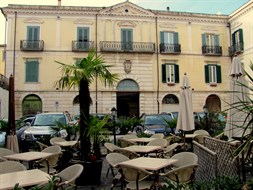Between Abruzzo and Molise: the county of Monteodorisio and Isernia
Between Abruzzo and Molise stretched the old county of Monteodorisio, a vast and rich territory near the lordship of Vasto, which included 17 castles and country houses, and several towns such as Monteodorisio, the capital of the county, Gissi, Pennaluce, Pollutri, Casalbordino and Cupello. The county came into the possession of the d’Avalos in the sixteenth century. With rich woods, overlooking the Adriatic Sea, fertile, and with numerous mountain villages, the county became a privileged place to hunt, but also important for its agricultural land and defense. Besides the beauty of the landscape and places, placed between the high peaks of the Maiella and the sea, the various fortified villages that lie along the area are worth visiting, some of which retain their charm, and the fortified towers, some erected by the d’Avalos along the coast, such as that of the Tagliata and the Bufalara. Some centres, such as Monteodorisio, still contain old castles having been at once defensive points which controlled the land and residences of the gentry.
 Continuing inward – reaching the towns of Casalanguida, Colledimezzo, Liscia, which belong to the county of Monteodorisio – one enters the current region of Molise, one of the two most important cities of which is also strongly linked to the d’Avalos. In the nineties of the seventeenth century, the city of Isernia came into the possession of Diego d’Avalos, who sold it to the Costanzo family. In 1710, however, Cesare Michelangelo d’Avalos rescued the fief. Prince Diego d’Avalos, evidently eager to reside there for long periods, built the family palace there, known as “il Palazzotto” (picture), located in Piazza Trento e Trieste. At the beginning of the nineteenth century it was devastated by two earthquakes and was later restored by Don Onofrio Laurelli (hence the name Palazzo d’Avalos-Laurelli). It also encompasses one of the medieval towers in the city, which, it is assumed, were part of an ancient Lombard castle that has now disappeared.
Continuing inward – reaching the towns of Casalanguida, Colledimezzo, Liscia, which belong to the county of Monteodorisio – one enters the current region of Molise, one of the two most important cities of which is also strongly linked to the d’Avalos. In the nineties of the seventeenth century, the city of Isernia came into the possession of Diego d’Avalos, who sold it to the Costanzo family. In 1710, however, Cesare Michelangelo d’Avalos rescued the fief. Prince Diego d’Avalos, evidently eager to reside there for long periods, built the family palace there, known as “il Palazzotto” (picture), located in Piazza Trento e Trieste. At the beginning of the nineteenth century it was devastated by two earthquakes and was later restored by Don Onofrio Laurelli (hence the name Palazzo d’Avalos-Laurelli). It also encompasses one of the medieval towers in the city, which, it is assumed, were part of an ancient Lombard castle that has now disappeared.
